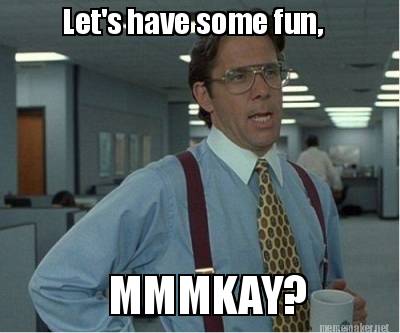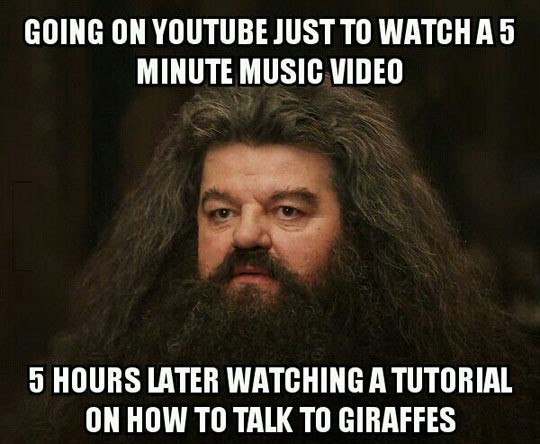YouTube
I know, I know...
We've all been there. BUT YouTube can be a huge asset to your classroom, and specifically your music classroom. Click HERE for some great starting points. I just got lost under the Arts tab. Visual art and musical art are connected throughout history. How great would it be to integrate with the art teacher in your school? She could play this video relating Baroque and Renaissance periods while talking about her subject. At the same time, you could discuss and do activities on the topic of music on these two eras. The downfall to these databases, is that there are no music links, but integration is key for us music teachers and this amazing resource!
Are you ready for some more tips and tricks on incorporating YouTube into your classroom?
Thank you for your enthusiasm, Captain! Here goes:
- If you want to show part of a YouTube video use TubeChop. It is free! Narrow to the part of the video that you want to view. This is great for when you want to take make it straight and to the point.
- I use YouTube for music all. the. time. So, if you wantt o create an mp3 of the audio of a video use this: ListenToYouTube.com.
- Playlists are awesome! I use the same videos throughout the week's lessons. So, I can save my videos in a playlist to quickly go to. I could also save videos to a certain playlist so that I could view them later. You can even share your playlists with your coworkers with a shareable link! Don't underestimate the power of creating playlists. You can search for others' playlists as well. I found some great videos on lessons in the music classroom from others' playlists-it's like finding a sunken treasure! "X" marks the spot people!
- If you are a little more advanced with your technology, and you are embedding a video onto your website, blog, etc, then be sure to uncheck the option “Show suggested videos when the video finishes." This option shows up when you copy the embed code. This stops the videos at the end of of your intended video from popping up. You never know what you're going to get there.
- I have not used http://www.educanon.com/, but you can upload a YouTube video and embed formative assessments right into the video. Apparently, you can also track whether your students have watched it or not.
- Webcam Capture. Um hello?!?!?! This is perfect for the performing arts! Students need to be logged in to their Google account with a webcam. When they click Upload and choose "Webcam Capture" they can record their performance for you. So cool! Grading at your convenience and not taking up precious class time, anyone? Yes, puh-lease! Again, I have not used this yet in the classroom, so in theory it sounds amazing. I'll let you know if it all works out!
- This one rocked my world! How many times do you wish you could skip the huge introduction to a video and start right at 1:02? Well, this is a thing! When you get to the point of the video you want to start at, pause, click the share button and check the box that says “Start at.” Voila! It will start at 1:02 if you so choose. Want to cut it short? Add #t=xmys to the end of video. X=minutes and Y=seconds.
- Turn Off the Lights. Try it. Now.
I know this is a lot to soak in, but these were my favorites of the features I looked into, with the exception of the two I have not personally tried, but WILL try out soon!
Google Storybuilder
This is a fun way for students to be creative. Storybuilder tells a story with text. There are no voice overs or recordings to add to the story. The story also needs to be short and sweet. I found you can only add 10 text entries. Now you can get pretty creative with this by deleting previous text entries in of of the entry boxes to free up space, but I foresee this getting complicated for the elementary age students. Although there are definitely some kiddos that you could have them do this as an extension activity. Take a look at the sample stories here to see what I am talking about:
http://docsstorybuilder.appspot.com/. See how the deleting of past text can be somewhat complicated for the littles? Here is one I did about my relationship with my coffee machine: https://goo.gl/uHrTgW.
Here is how you could use Google Storybuilder in your MUSIC classroom:
- Explain new music terms
- Interview musicians or composers
- Explain music concepts
Tips for Google Storybuilder
1. Get started here: https://goo.gl/uHrTgW.
2. Once you get to the website click "GET STARTED." It will take you right to the text entry boxes.
3. I would have the script typed out before hand. I did this, and it saved my backside. I didn't know that there was a limit of 10 entries. So, instead of starting over from the beginning, I edited my script and then copy and pasted into the boxes after my edits.
4. You have the option to add music, however I have not been able to hear the music on my laptop. I'm not sure what I am doing wrong there. If you can help me out with that, let me know!
5. You can preview your story as you go, so make sure to take a loot at it before you publish it.
6. Copy your link when you are satisfied and paste away!
Other Fun Stuff From Google
Google Translate
Google Translate is a pretty remarkable tool, if you ask me. It is pretty self-explanatory to use. You choose your starting and ending languages, and type what you want translated. As you are typing the phrase that you want translated, it immediately populates the translation. So how in the world would you use this in your MUSIC classroom? Definitely not every day, but it would be really fun for the students to use as an exploratory tool.
- Let's say you give them a piece of sheet music that has all of these foreign terms throughout. Tell them the language of the music terms, and have them translate it to English. This would be a fun way for them to learn, instead of you telling them, it goes in one ear, then right out the other. (ex. allegro, presto, moderato, etc.)
- Do your students compose? Of course they do! How often do they compose lyrics in another language. Probably not often. This would be a fun learning experience in how syllables work with rhythms/notation, or rhyming changes with the language.
Google Hangouts
Let's say you have music pen pals from Spain. Maybe they composed a song in English, used Google Translator to create a Spanish version, then shared their lyrics with their pen pal. Cool, right? What's better is that they could actually see each other through live video with this! Students could share performance ensembles, music likes/dislikes, cultural music, and so much more with a pen pal. Google Hangouts is available with video, phone, or text options. It took me a little more than exploring to figure out how this works. I watched this video, and then I was all set. So take a look to get started.
We teachers can of course use this professionally as well. How often do you get to observe other music teachers in their own classroom and in their own environment- not just teaching sample lessons to other music teachers? Rarely. If ever! The only time I was able to do this was during my student teaching experience. What if we set up Hangouts to video as a cohort is teaching? Set your webcam up in the back of the classroom and invite others to watch you. I would foresee doing this during my lunch or plan time. I could team up with another teacher I so desperately want to watch, he/she would have to agree to set up the webcam for me to watch, and then let the learning begin. Now I have not taken personal time to watch, it is not during a PD time without students, and travel time is not needed either. I could really see using this a lot.
I hope you enjoyed your stop today! Have you used any of these tools? Do other ideas spark when you read this? Please share your stories with me and others below!





No comments:
Post a Comment